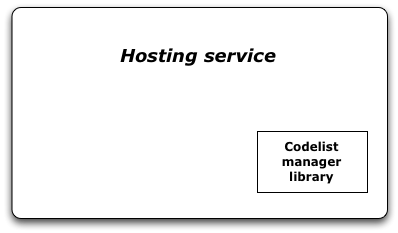Difference between revisions of "Codelist Manager"
Lucio.lelii (Talk | contribs) |
m |
||
| (12 intermediate revisions by 2 users not shown) | |||
| Line 3: | Line 3: | ||
|} | |} | ||
| − | A | + | A component supporting the entire life-cycle of code lists management including creation (via ingestion if they exists), curation and publishing. |
| + | Code lists are also known as controlled vocabularies or coded value enumerations. | ||
| + | They are particularly important at (a) data dissemination and exchange layer among different organisations and (b) at data reporting and production, as to ease the mutual understanding between the originator and the consumer. | ||
| + | They represents a key concept in the statistical data management. | ||
| + | |||
This document outlines the design rationale, key features, and high-level architecture, as well as the options deployment. | This document outlines the design rationale, key features, and high-level architecture, as well as the options deployment. | ||
== Overview == | == Overview == | ||
| − | The goal of this | + | The goal of this component is to simplify the management of code lists. |
| + | In particular, it is mainly conceived to support the entire life-cycle of code list from their creation to their exploitation. | ||
| − | The | + | The component allows to create a code list by acquiring the data forming it via a file storing them in a csv (comma separated values) format or via the [http://sdmx.org/ SDMX protocol] (a reference standard for Statistical data). |
| + | |||
| + | <!-- === Key features === | ||
| + | |||
| + | <font color=red>TO BE COMPLETE</font> --> | ||
== Design == | == Design == | ||
| Line 16: | Line 25: | ||
=== Philosophy === | === Philosophy === | ||
| − | + | The goal of this component is to offer code list management facilities by abstracting on various aspects including the storage model and the data distribution across diverse storage units. | |
| − | + | Moreover, another distinguishing aspect is the automatic recording and injection of additional information characterising the code list evolution for provenance and versioning purposes. | |
| − | + | ||
| − | + | <!-- === Architecture === | |
| − | + | <font color=red>Only the library?</font> --> | |
| − | + | == Deployment == | |
| − | + | This library must be co-deployed with the hosting service. | |
| − | + | ||
| − | + | ||
| − | + | ||
| − | + | ||
| − | + | ||
| − | + | ||
| − | + | ||
| − | + | ||
| − | + | ||
=== Small deployment === | === Small deployment === | ||
| − | + | [[Image:codelistmanager.png|frame|center|Small Deployment]] | |
| − | + | ||
| − | [[Image: | + | |
== Use Cases == | == Use Cases == | ||
| Line 48: | Line 45: | ||
=== Well suited Use Cases === | === Well suited Use Cases === | ||
| − | + | This library is particularly suited for the use in the services that need codelists. | |
| − | + | ||
| − | + | ||
Latest revision as of 17:47, 5 November 2012
A component supporting the entire life-cycle of code lists management including creation (via ingestion if they exists), curation and publishing. Code lists are also known as controlled vocabularies or coded value enumerations. They are particularly important at (a) data dissemination and exchange layer among different organisations and (b) at data reporting and production, as to ease the mutual understanding between the originator and the consumer. They represents a key concept in the statistical data management.
This document outlines the design rationale, key features, and high-level architecture, as well as the options deployment.
Overview
The goal of this component is to simplify the management of code lists. In particular, it is mainly conceived to support the entire life-cycle of code list from their creation to their exploitation.
The component allows to create a code list by acquiring the data forming it via a file storing them in a csv (comma separated values) format or via the SDMX protocol (a reference standard for Statistical data).
Design
Philosophy
The goal of this component is to offer code list management facilities by abstracting on various aspects including the storage model and the data distribution across diverse storage units.
Moreover, another distinguishing aspect is the automatic recording and injection of additional information characterising the code list evolution for provenance and versioning purposes.
Deployment
This library must be co-deployed with the hosting service.
Small deployment
Use Cases
Well suited Use Cases
This library is particularly suited for the use in the services that need codelists.
